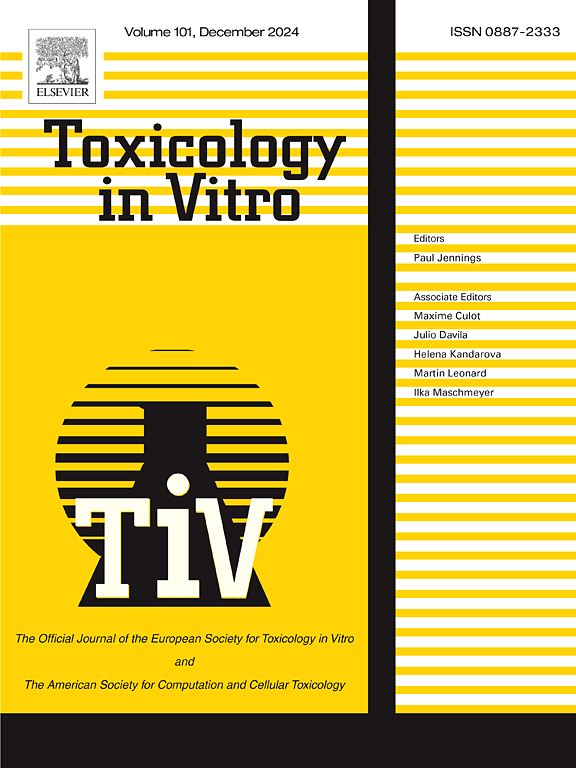三方基序 22 与蛋白磷酸酶镁依赖性 1 A 相互作用,加剧辐射诱导的肺上皮细胞上皮-间充质转化和纤维化。
IF 2.6
3区 医学
Q3 TOXICOLOGY
引用次数: 0
摘要
辐射诱导的肺损伤(RILI)是辐射对肺组织造成的损伤。辐射肺上皮细胞的上皮-间质转化(EMT)和纤维化在 RILI 中起着关键作用。含三方基序(TRIM)的家族蛋白已被证明参与了纤维化疾病,但TRIM22是否在RILI中发挥作用以及相关的内在机制仍有待探索。在此,我们报告了一项独特的综合分析,研究了TRIM22对辐射诱导的A549和BEAS-2B细胞EMT和纤维化的影响。细胞活力和增殖是通过细胞计数试剂盒(CCK)-8和集落形成试验来测定的。共免疫沉淀法验证了 TRIM22 与蛋白磷酸酶镁依赖性 1 A(PPM1A)之间的相互作用。染色质免疫沉淀试验验证了 SMAD3 与 TRIM22 启动子之间的相互作用。8 Gy辐射降低了细胞的活力和增殖。辐射后TRIM22的升高呈剂量和时间依赖性,敲除TRIM22可减少EMT和纤维化。TRIM22可与PPM1A相互作用并促进其泛素化,从而激活TGF-β1/Smad通路。过表达PPM1A会抑制TRIM22介导的EMT和纤维化。同时,SMAD3可与TRIM22启动子结合,从而提高其表达。这项研究揭示了一种新型的TRIM22/PPM1A/Smad3信号通路,该通路有助于raddition诱导的EMT和纤维增生,这将为治疗RILI提供新的靶点和策略。本文章由计算机程序翻译,如有差异,请以英文原文为准。
Tripartite motif 22 interacts with protein phosphatase magnesium-dependent 1 A to aggravate radiation-induced epithelial-mesenchymal transition and fibrogenesis in lung epithelial cells
Radiation-induced lung injury (RILI) is the damage to lung tissue caused by radiation. Epithelial-mesenchymal transition (EMT) and fibrogenesis in radiated lung epithelial cells play critical roles in RILI. Tripartite motif-containing (TRIM) family proteins have been shown to be involved in fibrotic diseases, but whether TRIM22 plays a role in RILI and relative underlying mechanism remain unexplored. Here, we reported a unique comprehensive analysis of the impact of TRIM22 on radiation-induced EMT and fibrogenesis in A549 and BEAS-2B cells. Cell viability and proliferation were measured by Cell-Counting Kit (CCK)-8 and colony formation assays. The interaction between TRIM22 and protein phosphatase magnesium-dependent 1 A (PPM1A) was validated using co-immunoprecipitation. A chromatin immunoprecipitation assay was used to verify the interaction between SMAD3 and TRIM22 promoter. Cell viability and proliferation were decreased by 8 Gy raddition. TRIM22 was elevated in a dose- and time-dependent manner after radiation, and its knockdown reduced EMT and fibrogenesis. TRIM22 could interact with PPM1A and promote its ubiquitination to activate the TGF-β1/Smad pathway. The overexpression of PPM1A abolished TRIM22-mediated EMT and fibrogenesis. Meanwhile, SMAD3 could bind to the TRIM22 promoter to elevate its expression. This study revealed a novel TRIM22/PPM1A/Smad3 signaling pathway that contributes to the raddition-induced EMT and fibrogenesis, which would provide novel targets and strategies for treating RILI.
求助全文
通过发布文献求助,成功后即可免费获取论文全文。
去求助
来源期刊

Toxicology in Vitro
医学-毒理学
CiteScore
6.50
自引率
3.10%
发文量
181
审稿时长
65 days
期刊介绍:
Toxicology in Vitro publishes original research papers and reviews on the application and use of in vitro systems for assessing or predicting the toxic effects of chemicals and elucidating their mechanisms of action. These in vitro techniques include utilizing cell or tissue cultures, isolated cells, tissue slices, subcellular fractions, transgenic cell cultures, and cells from transgenic organisms, as well as in silico modelling. The Journal will focus on investigations that involve the development and validation of new in vitro methods, e.g. for prediction of toxic effects based on traditional and in silico modelling; on the use of methods in high-throughput toxicology and pharmacology; elucidation of mechanisms of toxic action; the application of genomics, transcriptomics and proteomics in toxicology, as well as on comparative studies that characterise the relationship between in vitro and in vivo findings. The Journal strongly encourages the submission of manuscripts that focus on the development of in vitro methods, their practical applications and regulatory use (e.g. in the areas of food components cosmetics, pharmaceuticals, pesticides, and industrial chemicals). Toxicology in Vitro discourages papers that record reporting on toxicological effects from materials, such as plant extracts or herbal medicines, that have not been chemically characterized.
 求助内容:
求助内容: 应助结果提醒方式:
应助结果提醒方式:


